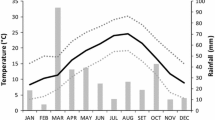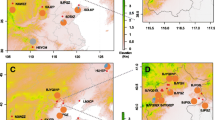Abstract.
Restricted migration and habitat fragmentation promote genetic differentiation between populations: Because most of the hosts of Panonychus citri are woody plants, mainly citrus trees that are usually planted at intervals of several metres, this mite likely faces more risks (e.g., starvation) by dispersing between host plants, compared to other spider mite species that infest both herbaceous and woody plants, such as Tetranychus urticae. Such a limited gene flow between patches (host plants) can lead to differentiation of populations even within a small area. Therefore, we hypothesize that P. citri populations are genetically differentiated not only between distant populations but also within small areas, such as within a grove. To test this hypothesis, we investigated the divergence of P. citri populations in Japanese citrus groves according to a hierarchical arrangement of geographical distance, ranging from distant populations (10 groves distributed throughout different areas in two major Japanese islands; this level of analysis is referred to as ‘geographic’) to local populations (different trees in a specific grove; ‘local’). Three molecular markers were used an esterase locus, one microsatellite and a point mutation in the mitochondrial cytochrome oxidase subunit I. At a local level acaricide susceptibility tests were also performed using two acaricides: fenpyroximate (25 ppm) and etoxazole (3.33 ppm). At a broad geographic level the gene diversity decreased with decreasing area size and distance between populations. By contrast, at the local level, populations maintained a significant level of variation between trees within groves, and the divergence within groves was higher than between groves. Whereas no statistical difference of the mortalities was detected among groves for the two acaricides tested, the difference was statistically significant among trees within groves in fenpyroximate (ANOVA, p < 0.025) and marginal in etoxazole (0.1 < p < 0.05). We concluded that P. citri populations maintain a higher level of variation between trees (or patches of trees) within groves than between groves at the local level, though the gene diversity tended to be smaller with decreasing distance between populations at the geographical level. Results are discussed in relation to the dispersal behaviour of spider mites.
Similar content being viewed by others
References
W.S. Abbott (1925) ArticleTitleA method of computing the effectiveness of an insecticide J. Econ. Entomol. 18 265–267
R. Beckwitt (1980) ArticleTitleGenetic structure of Pileolaria pseudomilitaris (Polychaeta: Spirorbidae) Genetics 96 711–726 Occurrence Handle7262543
H.R. Bolland J. Gutierrez C.H.W. Flechtmann (1998) World Catalogue of the Spider Mite Family (Acari: Tetranychidae) Brill Leiden
R. Chakraborty (1980) ArticleTitleGene-diversity analysis in nested subdivided populations Genetics 96 721–726
R. Chakraborty M. Haag N. Ryman G. Ståhl (1982) ArticleTitleHierarchical gene diversity analysis and its application to brown trout population data Hereditas 97 17–21
R. Chakraborty O. Leimar (1987) Genetic variation within a subdivided population N. Ryman F. Utter (Eds) Population Genetics and Fishery Management University of Washington Press Seattle 89–120
R. ffrench-Constant K. Aronstein N. Anthony C. Coustau (1995) ArticleTitlePolymerase chain reaction-based monitoring techniques for the detection of insecticide resistance-associated point mutations and their potential applications Pestic. Sci. 43 195–200
C.A. Fleschner M.E. Badgley D.W. Ricker J.C. Hall (1956) ArticleTitleAir drift of spider mites J. Econ. Entomol. 49 624–627
K. Furuhashi M. Nishino (1978) ArticleTitleStudies on the dispersal of citrus red mitePanonychus citri McG Bull. Shizuoka Pref. Citrus Exp. Stn. 14 29–42
K. Goka K. Okabe M. Yoneda S. Niwa (2001) ArticleTitleBumblebee commercialization will cause worldwide migration of parasitic mites Mol. Ecol. 10 2095–2099 Occurrence Handle10.1046/j.0962-1083.2001.01323.x Occurrence Handle11555253
T. Gotoh M. Kubota (1997) ArticleTitlePopulation dynamics of the citrus red mitePanonychus citri (McGregor) (Acari: Tetranychidae) in Japanese pear orchards Exp. Appl. Acarol. 21 343–356 Occurrence Handle10.1023/A:1018467526187
D.L. Hartl (2000) A Primer of Population Genetics, 3rd ed Sinauer Associates SunderlandMA
S. Iwao (1968) ArticleTitleA new regression method for analyzing the aggregation pattern of animal populations Res. Popul. Ecol. 10 1–20
D.H. Janzen (1970) ArticleTitleHerbivores and the number of tree species in tropical forests Am. Nat. 104 501–528 Occurrence Handle10.1086/282687
L. Jeppson H.H. Keifer E.W. Baker (1975) Mites Injurious to Economic Plants University of California Press Berkeley
G.G. Kennedy D.R. Smitley (1985) Dispersal W. Helle M.W. Sabelis (Eds) Spider Mites: Their Biology, Natural Enemies and Control NumberInSeriesVol. 1A. Elsevier Amsterdam 233–242
Y. Kunimoto N. Shinkaji H. Amano (1993) ArticleTitleSpread of the citrus red mitePanonychus citri (McGregor) (Acari: Tetranychidae), from Ilex crenata Thunb. to a Japanese-pear orchard Jpn. J. Appl. Entomol. Zool. 37 69–73
C.M. Miller-Butterworth D.S. Jacobs E.H. Harley (2003) ArticleTitleStrong population substructure is correlated with morphology and ecology in a migratory bat Nature 424 187–191 Occurrence Handle10.1038/nature01742 Occurrence Handle12853955
M. Navajas M.J. Perrot-Minnot J. Lagnel A. Migeon T. Bourse J.M. Cornuet (2002) ArticleTitleGenetic structure of a greenhouse population of the spider mite Tetranychus urticae: spatio-temporal analysis with microsatellite markers Insect Mol. Biol. 11 157–165 Occurrence Handle10.1046/j.1365-2583.2002.00320.x Occurrence Handle11966881
M. Nei (1973) ArticleTitleAnalysis of gene diversity in subdivided populations Proc. Natl. Acad. Sci. USA 70 3321–3323 Occurrence Handle4519626
M. Nei (1987) Molecular Evolutionary Genetics Columbia University Press New York
M. Osakabe (1991) ArticleTitleGenetic analysis of esterases in the citrus red mitePanonychus citri (McGregor) (Acari: Tetranychidae) Appl. Entomol. Zool. 26 307–312
M. Osakabe N. Hinomoto S. Toda S. Komazaki K. Goka (2000) ArticleTitleMolecular cloning and characterization of a microsatellite locus found in a RAPD marker of a spider mitePanonychus citri (Acari: Tetranychidae) Exp. Appl. Acarol. 24 385–395 Occurrence Handle10.1023/A:1006405325992 Occurrence Handle11156164
M. Osakabe T. Hirose M. Sato (2002) ArticleTitleDiscrimination of four Japanese Tetranychus species (Acari: Tetranychidae) using PCR-RFLP of the inter-transcribed spacer region of nuclear ribosomal DNA Appl. Entomol. Zool. 37 399–407 Occurrence Handle10.1303/aez.2002.399
M. Osakabe S. Komazaki (1999) ArticleTitleLaboratory experiments on a change in genetic structure with an increase of population, Panonychus citri (McGregor) (Acari: Tetranychidae) Appl. Entomol. Zool. 34 413–420
M. Osakabe Y. Sakagami (1993a) ArticleTitleProtein differences detected by two-dimensional electrophoresis among local populations of Panonychus citri (McGregor) (Acari: Tetranychidae) in Japan Appl. Entomol. Zool. 28 497–502
M. Osakabe Y. Sakagami (1993b) ArticleTitleEstimation of genetic variation in Japanese populations of the citrus red mitePanonychus citri (McGregor) (Acari: Tetranychidae) on the basis of esterase allele frequencies Exp. Appl. Acarol. 17 749–755
P.E. Smouse R.H. Ward (1978) ArticleTitleA comparison of the genetic infrastructure of the Ye’cuana and the Yanomama: a likelihood analysis of genotypic variation among populations Genetics 88 611–631 Occurrence Handle640379
R.R Sokal F.J. Rohlf (1995) Biometry 3rd ed W. H. Freeman and Company New York
A. Takafuji (1986) ArticleTitleEffectiveness of second mating for two incompatible types of the citrus red mitePanonychus citri (McGregor) Res. Popul. Eco1. 28 91–101
A. Takafuji H. Fujimoto (1986) ArticleTitleWinter survival of the non-diapausing population of the citrus red mitePanonychus citri (McGregor) (Acarina: Tetranychidae) on pear and citrus Appl. Entomol. Zool. 21 467–473
A. Takafuji N. Morimoto (1983) ArticleTitleDiapause attributes and seasonal occurrences of two populations of the citrus red mitePanonychus citri (McGregor) on pear (Acarina: Tetranychidae) Appl. Entmol. Zool. 18 525–532
S. Toda M. Osakabe S. Komazaki (2000) ArticleTitleInterspecific diversity of mitochondrial COI sequences in Japanese Panonychus species (Acari: Tetranychidae) Exp. Appl. Acarol. 24 821–829 Occurrence Handle10.1023/A:1006484018547 Occurrence Handle11345318
S. Toda M. Osakabe S. Komazaki (2001) ArticleTitleDetection of a point mutation in mitochondrial COI gene of Panonychus citri (Acari: Tetranychidae) using PCR amplification of specific alleles J. Acarol. Soc. Jpn. 10 37–41
A. Tsagkarakou M. Navajas J. Lagnel N. Pasteur (1997) ArticleTitlePopulation structure in the spider mite Tetranychus urticae (Acari: Tetranychidae) from Crete based on multiple allozymes Heredity 78 84–92 Occurrence Handle10.1038/sj.hdy.6881050
K. Wanibuchi Y. Saito (1983) ArticleTitleThe process of population increase and patterns of resource utilization of two spider mites, Oligonychus ununguis (Jacobi) and Panonychus citri (McGregor), under experimental conditions (Acari: Tetranychidae) Res. Popul. Ecol. 25 116–129
A. Yamamoto H. Yoneda R. Hatano M. Asada (1995) ArticleTitleField selection experiments with hexythiazox in the citrus red mitePanonychus citri (McGregor) J. Pesticide Sci. 20 307–315
K.Y. Zhu J.M. Clark (1996) ArticleTitleAddition of a competitive primer can dramatically improve the specificity of PCR amplification of specific alleles BioTechniques 21 586–590 Occurrence Handle8891204
Author information
Authors and Affiliations
Corresponding author
Rights and permissions
About this article
Cite this article
Osakabe, M., Goka, K., Toda, S. et al. Significance of habitat type for the genetic population structure of Panonychus citri (Acari: Tetranychidae). Exp Appl Acarol 36, 25–40 (2005). https://doi.org/10.1007/s10493-005-1672-1
Received:
Accepted:
Issue Date:
DOI: https://doi.org/10.1007/s10493-005-1672-1




